March 14, 2008 8:25 AM CDT
Pavers in Hardscaping
Get masonry industry news in your inbox
Subscribe to Masonry Messenger to receive the masonry resources and information you need to stay current.
No Thanks
X
A case-by-case study of best practices, techniques and products
By
Brian E. Trimble, P.E., LEED AP
Several award-winning projects from the Brick Industry Association's 2007 Brick In Architecture Awards competition have been examined through case studies. These case studies break down different installation systems for pavers.
Case Study 1: Medinah Country Club - Medinah, Ill.
Award: Gold, Paving and Landscape Category
Installation System: Sand-Setting Bed on Aggregate Base
Landscape Architect: Private Gardens, Public Spaces, Inc.
Contractor: R. Sanchez & Sons
Manufacturers: The Belden Brick Co. and Endicott Clay Products Co.
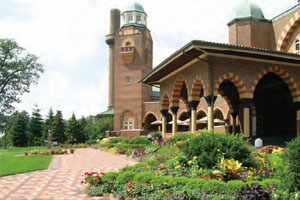
Creating new spaces that connect back to a distinctive architectural heritage.
When the PGA scheduled a major golf tournament at a distinguished country club in suburban Chicago, the club members determined to make the grounds around their clubhouse as impressive as was their renowned golf course. Private Gardens, Public Places Inc. was hired to create new terraces, gardens and walkways serving the clubhouse and the practice putting green. This area, which was to be spotlighted on national television, was also to be a traffic hub, providing safe pathways to the front doors, the locker rooms and the pool passage, despite being surrounded by the clubhouse's main driveway. The goal was to make the new gardens and the existing building appear as if they were built at the same time. The clubhouse, which was completed in 1924 in the Moorish Revival style so popular at the time, challenged the firm with its style and mass. Which architectural features, repeated in the landscape, would best tie the building and landscape together? With these questions in mind, the firm traveled to southern Spain to research, first-hand, Moorish design, architecture and gardens.
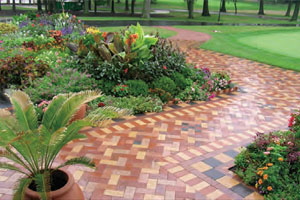
Clay pavers were chosen because of the variety of available colors.
R. Sanchez & Sons was asked to install the mosaic of clay pavers. The clay pavers were chosen because of the variety of available colors. Initial planning was key in making this project successful. To blend in with the structure, they had to do a lot of mathematical gymnastics to make the patterns work properly. The placement of each brick was called out, since there were seven colors in the patterns. To assure future maintenance would be minimized, a 12-inch crushed limestone base was used, though many local projects use six- to eight-inch bases. A sand-setting bed was laid on top of the base and the pavers set in it. Brick edging was set in concrete to act as an edge restraint. In laying the pavers, the installers left just enough space for sand to filter into the joints and keep the pavers edges from chipping. The pavement also had a crown along it, which created a slight wedge shape to the joint and helped keep the joints from being too tight at the top edge. This also kept the pavers from touching and possibly chipping in service.
After hosting a past PGA Championship, Medinah Country Club and its grounds are ready to host other major tournaments with the likes of Tiger Woods.
Case Study 2: Northeastern University - Buildings G and H, Boston
Award: Best In Class, Paving and Landscape Category
Installation System: Brick with Sand-Filled Joints, Bituminous-Setting Bed and Asphalt Base
Landscape Architect: Pressley Associates, Landscape Architects
Manufacturers: The Stiles & Hart Brick Co.
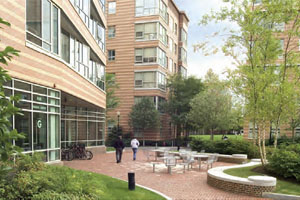
Making an inviting gateway in the middle of a busy urban environment.
At Northeastern University, the construction of two new buildings presented the opportunity to create a new campus entrance from the adjacent Avenue of the Arts, a major Boston thoroughfare and home to multiple cultural institutions. The new gateway entrance, defined by the two buildings, skillfully utilizes clay brick pavers to establish an inviting planned sequence of pedestrian experiences. Entering the university campus, students, faculty and staff are invited to follow wide, curving, brick pathways that comfortably accommodate pedestrians, joggers and the handicapped. As visitors continue along these paved thoroughfares, they encounter small pocket parks, promenades and open quadrangles.
Traditionally used throughout the university campus, the red brick pavers blend harmoniously with the warm tones of the surrounding buildings. They will maintain their color and functionality over time with minimal maintenance. The brick also offers a highly durable surface that readily accommodates emergency and service traffic.
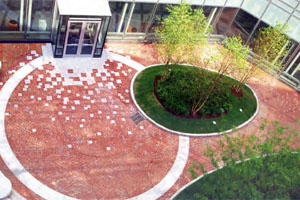
Red brick pavers blend harmoniously with the warm tones of the surrounding buildings.
To enliven and distinguish the outdoor seating areas at the building entrances, the main path's carpet of red clay pavers is punctuated with accent pavers. A surrounding field of irregular, hand-molded lines of specialized clay brick softens the rigid lines and saw-cut edges of the contrasting pavers. For all who visit, the finished hardscape creates an inviting gateway and welcome oasis in the midst of the busy surrounding urban environment.
The pavement consisted of an asphalt base overlaid with a bituminous setting bed, modified neoprene tack coat and brick pavers laid hand-tight. Brick pavers have been laid in this system on the campus for the last 25 years and have become standard at the university. The asphalt base is used in urban locations to deal with soft spots in the soil and make the pavement stronger. Sandstruck pavers are used on this project. While these units often have some unique variations in them, they have worked well with this type of system. The system holds these units in place while keeping a narrow sand-filled joint. Once known as the "Hastings Pavement System" named for the asphalt block pavers that made it popular, it is now used in many pavements subject to vehicular traffic.
Case Study 3: American Tobacco Historic District Renovation - Durham, N.C.
Award: Gold, Paving and Landscape Category
Installation System: Sand-Setting Bed on Aggregate Base and Sand-Setting Bed on Concrete Base
Landscape Architect: Belk Architecture
Contractor: Fred Adams Paving Co.
Manufacturers: Pine Hall Brick Co.
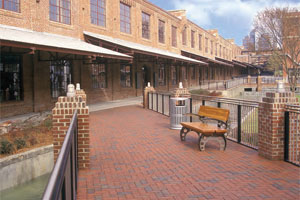
Transforming an industrial complex into a vibrant, mixed-use district.
The project called for creating a new life for a dormant industrial complex composed of 10 buildings constructed between 1874 and 1954 in downtown Durham, N.C. The existing brick buildings, enclosing more than 1 million square feet in various states of disrepair, surround a central courtyard containing the site's signature water tower. Belk Architecture's task was to adapt the former factory into a vibrant, mixed-activity center, while retaining and enhancing the architectural integrity of the buildings. Existing buildings were carefully repaired and restored, new interior lobbies were created, and two new parking facilities were integrated into the campus. Inside the courtyard, the water tower and brick chimney were stabilized and repainted, asphalt removed and replaced with landscaping and lawn, and a new water feature created. The water feature is a 440,000-gallon re-circulating river flowing through the project, Bull River.
The landscape architecture firm of Smallwood, Reynolds, Stewart, Stewart & Associates used brick pavers to tie the surrounding buildings together. The architect developed a blend of colors, since the buildings each varied in color. Clay brick was the only material considered, as they didn't want to introduce new materials into this historic district. Bold diagonal lines are used for direction, and the bridges crossing the river are covered with brick pavers to connect the site.
Two paving systems were used on the project: brick set on an aggregate base and brick set on a concrete slab. In both cases, a sand-setting bed was used. The sand used for the setting bed conformed to ASTM C 33 concrete sand, since it provides better drainage than a mason's sand. The bridge had originally been designed as a steel bridge, but availability of steel was a problem. It was redesigned as a concrete bridge with a clay paver surface. The concrete deck served as a base for the clay pavers, which were then set in a sand-setting bed. Other areas of the project used an aggregate base, in many cases only four inches thick, to satisfy the pedestrian-only traffic. The contractor followed the Brick Industry Association's installation guidelines (Technical Notes 14 Series) to ensure a good job was performed.
Phase 1 of the redevelopment created an office, retail, restaurant and leisure destination with activity at the site continuing day and night. The use of brick has tied this unique development together. Surrounded by history and tradition, the "District" has become one of Durham's most active urban spaces.
About the Author
Brian E. Trimble, P.E., LEED AP, is senior director of Engineering Services & Architectural Outreach, Midwest/Northeast Region, for the Brick Industry Association (BIA). With more than 21 years of experience in the masonry industry, Trimble assists professionals in the design of brick and masonry structures and is a frequent lecturer to construction industry groups. He also heads up architectural and builder outreach in the 17-state Midwest/Northeast Region for the BIA.
Related Articles
More Masonry Headlines























